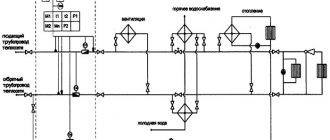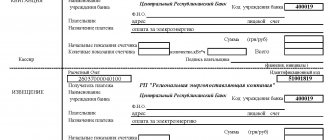Gas prices for the population of Moscow
Living in the territory of the Troitsky and Novomoskovsky administrative districts Directions for using gas Price (Including VAT 20%) Cooking and heating water using a gas stove (in the absence of other directions and using gas) 5.52 rub/m³ Heating water using a gas water heater in the absence central hot water supply (in the absence of other uses of gas) 5.52 rubles/m³ Cooking and heating water using a gas stove and heating water using a gas water heater in the absence of a central hot water supply (in the absence of other uses of gas) 5.52 rubles /m³ Heating with the simultaneous use of gas for other purposes (except for heating and (or) generation of electrical energy using boiler houses of all types and (or) other equipment that are in common shared ownership of the owners of premises in apartment buildings) in the presence of gas meters 5,530 .07 rub/1000 m³ Individual (apartment) heating of residential premises (residential buildings, apartments, rooms) within the standard standard area of residential premises in the absence of gas meters 5,530.07 rub/1000 m³ Individual (apartment) heating of residential premises (residential houses, apartments, rooms) in excess of the standard standard area of residential premises in the absence of gas meters 6,849.93 rubles/1000 m³ For other purposes (heating of non-residential premises) 7,075.08 rubles/1000 m³ Gas prices for the Moscow region and TiNAO G.
Moscow, valid from July 1, 2020 Gas prices for the Moscow region and TiNAO of Moscow, valid from January 1, 2020 Gas prices for the Moscow region and the city.
Moscow, valid from July 1, 2020 9:00 - 18:00 (Fri: until 16:45), Sat, Sun - closed Emergency services telephone number Send correspondence to the address - © 2020 Mosoblgaz JSC Made in
Who has gas at home?
How much is the monthly fee
- It’s probably worth clarifying that although we heat all winter, we only live on weekends.
- I just paid off the gas debt at my husband’s parents’ house from November 2020, 50 thousand. The house is large and stupid, the rooms are not used, there is no way to close them and not heat them. The house is about 300 m.
- We live permanently. The house is very well insulated, the area is almost 200 sq.m. At home it’s always 24-25 degrees, in the bathrooms and more, about 28. Warm floors in wet areas and in the kitchen. The heating main from the house to the small house is 30 m long, area 80 sqm, also 24 degrees in winter, etc. Gas provides hot water for 2 houses plus gas stoves. Expenses. In summer 1-1.5 r. Spring-autumn 2.5-4. Winter 4.5-5.5 months. Once it was about 6 in a very cold and windy month, but this was 1 time. The costs are fair, not fabulous
- Heating water costs 1,500 rubles for 5 people. This is in the summer when the heating is off. Shower every day, yes.
- House 130 m2 we come once every 2 weeks. When we are not there, we heat it with 15-16 degrees. Max. On average during the Central Russian winter - 2500 rubles. per month comes out (November to March).
- House 230 square meters. We live constantly. There haven't been more than three thousand yet. Heating plus stove, plus boiler heating.
- It's a pity of course.
For now it’s like a suitcase without a handle, it’s a shame to throw it away and hard to carry. We hope to live there when we don’t work. According to my calculations, another 10-12 years. - Super
- House 250 meters. In winter we live on short stays, but we heat constantly and reduce the temp, but not much, so as not to come to a cold house (at least 20 degrees) 3-4 thousand per month
- Thank you
- house about 100 square meters. in the winter season I paid 1-3 thousand per month for gas (depending on the weather). True, this is the Kaluga province; in the Moscow region, a cubic meter is probably more expensive.
- But there is a place to relax on the weekend and celebrate the New Year
- Gas prices have gone up a lot. But your friends pay a lot, maybe the house is not insulated enough? In Siberia, when the weather is -35 (December-January), we pay the amount of 10 thousand, but this includes heating the water (only cold water enters the house). Judging by the summer months, heating water costs 1,500 rubles. That is, heating in the most severe frosts costs 8500. The house is 400 sq. m.
- Please tell us honestly, how much do you pay per month for main gas (winter) in a normal winter and in the coldest weather? And of course the footage of the house. I always thought that gas costs pennies. Because my mother-in-law and sister have gas in their house and everything is cheap. But - my mother-in-law’s part of the house is 35-40 meters, and my sister’s house is 60 meters in total, so it turns out that it’s cheap. And those familiar with a house size of 300 m2 or more voice an amount of 8 -12 tr. in frosty months. Please write, I want to understand what to expect. Thank you
- It all depends on the boiler equipment, the insulation of the house, the average temperature in the house, which is comfortable for people. some have 16 degrees in the bedroom, others want 28. So the house is 380 square meters, the children wear T-shirts, sleep in cool pajamas, we ventilate by opening the windows, we live constantly, the STS Family boiler is 1200, the windows are very large 158x220, two in each middle room , the house is brick-built, insulated with a 100mm wet facade. Gas payment in the coldest weather is 8 thousand rubles.
- House 170 m2, heated all the time, 1800-2500 per month
- Thank you .
- Are you sure you are in Russia?
- Thank you, I understand. You probably have a nice house, isn’t it a pity that you don’t live there permanently?
- It depends on the insulation. Last winter, we spent an average of 5-6 thousand a month on electric heating of a house of 120 meters with an unlined attic (a large volume was heated for nothing. IMHO, 12 thousand for gas in a house is 2 times more, a lot.
- Write down at the same time how many cubes (or what are they measured in?) you have for such footage, otherwise it’s not clear.
- House of about 200 square meters, Moscow region. From 3 to 5 thousand per month. But we live in the house on short visits, so in our absence we reduce the heating. Plus, other buildings are heated at a time. In general, the heating rate will be directly proportional to the quality of the house’s insulation.
- House 200 meters, in winter 3000 rubles. But our house is warm, brick + plaster (fur coat) on the outside, and we don’t live in winter, so we heat it a little, +16+18 degrees, no more. When we arrive, we increase the temperature to 25 degrees once every 2 weeks. Also take into account how many people will live permanently; the water is also heated by gas. If 4 people in 200 sq.m. They live in the house all the time, wash dishes by hand and shower everything every day, then 10-12 thousand will easily come in.
- Cheap as
- The house is made of cylinders, 200 sq.m., during the winter about 12-13 thousand, or rather the entire heating season. The water is heated by an electric boiler. But in winter we travel for a total of less than 2 weeks. In our absence the temperature is approximately 18-20 degrees.
- Thank you . Cheap
New scheme. How they will start selling gas to Ukrainians from August 1 after the transition to market prices
Naftogaz has decided how it will sell gas to the population from August 1.
Let us remind you: from next month, special obligations on gas prices for household consumers will cease to apply, and people will need to pay market rates.
It was planned to launch the gas market for the population on July 1, but then the deadline was postponed another month - until August 1.
From August 1, residents of private houses with gas boilers will pay the full market price for gas. Residents of high-rise buildings are currently being transferred to market prices only for cooking gas. For heating, the PSO will continue to operate until the end of the next heating season, that is, until April 2021.
According to the scheme proposed by NAC, gas suppliers for people (that is, gas sales) from August 1 will be able to purchase the resource in different “packages” (with prepayment, payment every 10 days, monthly payment). The final gas price will depend on the chosen “tariff plan”. That is, each consumer will have their own tariff.
Also, NAC is already actively campaigning for Ukrainians to “change suppliers using a simplified scheme” and switch to them.
However, no matter which supplier Ukrainians choose, gas prices will still rise. There are no prices for residential consumers for August yet.
But, for example, for industry (which buys resources at market prices), NAC set a price tag of 4,168 hryvnia per thousand cubic meters, which is almost 1.5 times more expensive than household consumers paid in July (about 3 hryvnia per cubic meter).
And, judging by the macroeconomic forecast of the Cabinet of Ministers, gas prices will continue to rise.
Let's say that prices are expected to increase by 19% next year.
At the same time, according to the head of the Housing Union of Ukraine, Alexander Skubchenko, Naftogaz will be able to set literally any price tags. However, they, in theory, should not be lower than industrial prices.
“Strana” was looking into what the launch of the gas market on August 1 means and what will happen to tariffs.
Gas bags
A couple of days before the “H” date, a message appeared on the official website of Naftogaz about how NAC will sell gas to the population from August 1.
In it, in particular, gas supply companies are invited to enter into annual contracts with the NAC subsidiary. A standard contract template is also provided. It states that the price of gas is negotiable and is determined in each specific case based on the volumes purchased, method of payment, etc.
To determine the base price, NAC offers a so-called formula approach. The tariff will be determined monthly and communicated on the eve of the new billing month.
It is interesting that Naftogaz does not provide the formula itself for determining the gas tariff for household consumers. It is only indicated that “the price for annual contracts will be determined based on their quotations of international gas slaves (which ones are not specified - Ed. ), the current market spread and payment terms.”
Several payment terms are offered. It could be:
- 100% prepayment (probably in this case gas will be the cheapest);
- payment in installments every 10 days;
- payment monthly, until the 25th day of the month following the period.
Payment terms will be chosen by consumers themselves, with whom gas sales companies will sign individual contracts. Actually, the agreement between Gazsbyt and Naftogaz Trading will include all individual agreements with household consumers.
Naftogaz is also actively inviting Ukrainians to change suppliers according to a simplified scheme (legislative changes in this regard were recently approved by parliament, they are one of the structural beacons in the memorandum with the IMF).
To switch to Naftogaz, consumers only need to submit an application (can be done online) and send a package of documents. NJSC offers two packages to retail customers: “Monthly Gas” (with monthly price changes according to the market) and “Comfortable Gas”. The latter proposes purchasing certain volumes of gas for a year.
There is no price for this package yet, it is only stated that it will appear soon and will “pleasantly please you.” Naftogaz has also fully embraced marketing and invites consumers to register in an electronic account in exchange for prizes - branded cups and thermal mugs.
According to the director of the Naftogaz Commerce division, Willem Coppuls, in the near future NJSC will also present a line of products for all participants in the gas market - for different periods and on different conditions.
It is expected that these will be packages for a month, quarter, year. The sale of quarterly products for business will begin next week through the electronic platform of the Ukrainian Energy Exchange (currently gas is sold through it on a monthly basis).
Different price tags and
Two important conclusions follow from the new gas sales schemes described above.
Firstly , gas prices will be different for everyone. If under PSO the gas tariff for people is the same, no matter how much they pay, no matter how much gas they consume and what gas supply they are connected to, then from August 1 the situation changes.
Your individual gas price will depend on how much gas you buy and how you pay. Consumers who are willing to take a lot of gas and, ideally, pay for it in advance a year in advance can count on the minimum price tag.
The last condition is simply impossible for most Ukrainians, especially when it comes to gas for heating. After all, you need to immediately pay a considerable amount - 30 thousand hryvnia or more (depending on the heated area).
It is interesting that for late payments for gas sales companies (and therefore all their clients), Naftogaz has provided for serious penalties: a delay of five days is already a fine of 10% of the cost of unpaid gas. If the buyer (that is, gas sales) does not select the declared volumes of gas, he will have to pay a fine of 20% of the cost of the “extra” resource.
At the same time, it is not yet clear what the conditions will be for those consumers who enter into direct contracts with NAC. If Naftogaz offers a lower annual price tag and more convenient payment terms, it is possible that consumers will begin to switch to it. That is, in this way Naftogaz will be able to increase its customer base, which, according to Skubchenko, is more profitable for it than working through gas sales.
“The benefit is that payments are made directly. Some gas distribution companies do not always transfer money for gas on time, even if their consumers pay accurately. As a result, a debt is formed (today - 24 billion hryvnia - Ed .),” says Skubchenko.
There is one more nuance. Naftogaz has been identified as the supplier of last resort. This means that consumers who have debts will be transferred to it. Initially, the period of such “transfer” is 60 days. During this time, consumers should pay up and find new suppliers. But the Ministry of Energy is going to cancel the time frame, so Naftogaz will be able to get household consumers for a virtually unlimited period, says Yuriy Korolchuk, an analyst at the Institute for Strategic Research. NAC itself is targeting 20% of the retail market, that is, it plans to serve about 3 million household consumers. In addition, according to Korolchuk, the GTS operator is now, under all sorts of pretexts, not coordinating gas supply applications for gas selection, which will also allow Naftogaz to begin serving such consumers.
It is unclear where, in fact, the market itself is in the new gas scheme. After all, Ukrainians were promised that after the abolition of the PSO, they would be able not only to change suppliers, but also to choose lower price tags.
It turns out that the price tag will ultimately depend on the consumer himself (how much gas he is willing to take and how to pay), and the only way to switch to other conditions is essentially Naftogaz itself. That is, the choice will be only nominal.
“The promised competition will not happen, even if European gas traders start working (earlier experts said that they were already at a low start - Ed. ). Since everyone, in essence, will sell the same gas from Europe. Direct suppliers who have their own resources, say, Turkmen, Kazakh or the same Gazprom, will not work in our market,” notes Skubchenko.
“Overseas “philanthropists” have organized a wonderful business for themselves on the territory of Ukraine with the help of local “grant eaters” and mountain reformers. Now the national company, which occupies a dominant position in the market, has received a monopoly right to resell Ukrainian gas to Ukrainians at its subsidiary price. The “correct” distribution of the huge margin will be ensured by an “independent” supervisory board under the cover of a member of this supervisory board from the office of the president, Yulia Kovaliv, who is on a firm and stable salary from Naftogaz. “Perpetum Mobile” at the expense of suckers,” wrote the head of the Union of Home Owners, People’s Deputy Alexey Kucherenko, on his Facebook page.
Secondly , it turns out that the “Amsterdam Plus” formula, which until recently was used to calculate gas tariffs for the population, will no longer be valid (remember: it included the cost of gas on the TTF exchange and delivery to Ukraine). But there is no new clear formula yet, there is only a list of very vague factors that will influence the price.
“Naftogaz, as a gas monopolist, will have the opportunity to come up with its own formulas and regulate prices as it sees fit,” says Skubchenko.
How much will you have to pay for gas?
The main thing that interests people is what prices they will eventually have to pay for gas.
In this regard, there is no good news yet, no matter how sophisticated the sellers are in marketing and “pretty up” the gas packages.
Gas will only become more expensive in the near future. Naftogaz does not report gas prices for household consumers for August. But for business, the tariffs are already known. Thus, enterprises that buy 50 thousand cubic meters or more will pay 3.57 hryvnia per cubic meter (including VAT) for prepayment or 4.16 hryvnia for deferred payment. The tariff for those who purchase less than 50 thousand cubic meters is 4.16 hryvnia per cubic meter (including VAT). For business, the price tag has not changed compared to July. But the population paid less - 2.97 hryvnia per cubic meter plus a monthly fee (different for each gas supply).
That is, starting from August, the gas price for people may rise to 4.16 hryvnia per cubic meter. “The population will pay the same price tag as industry, unless the gas market is retroactively postponed again,” says Gennady Ryabtsev, project manager at the Psyche Scientific and Technical Center.
For consumer debtors, Naftogaz, as the supplier of last resort, promises a price of 2.8 hryvnia per cubic meter without VAT and delivery tariffs. “That is, the final tariff will be about 3.6 hryvnia. But it is unclear how long it will last, because the supplier of last resort, logically, should have a price 15-20% higher than other suppliers. Therefore, it is possible that NAC will increase the price tag for the heating season,” says Korolchuk.
An idea of the dynamics of gas price tags is given by the macroeconomic forecast, which was approved by the Cabinet of Ministers this week.
In particular, it forecasts that the cost of imported gas will rise from $125 per thousand cubic meters this year to $180 next year. In 2022, gas will cost $208, and in 2023 - $214. That is, a constant increase in prices is expected over the next three years.
At the same time, next year the price of gas for the population, according to the forecast of the Cabinet of Ministers, will increase by 19%, in 2021 - by 24%, and only by 2023 the price increase will decrease to 6%.
“At the same time, it is not clear why gas prices for the population will rise next year. After all, Naftogaz reported that it purchased record volumes for storage – about 20 billion cubic meters. They were purchased in the summer, at a low price. Why will people be forced to overpay,” says Skubchenko.
In addition, the monthly fee or the cost of gas delivery will continue to increase. NERC approved tariffs for gas distribution from July 1 of this year. They increased less than originally planned, but are still quite high. The specific amounts are different for different gas sales companies. The minimum price tag at Kievgaz is 28 kopecks per cubic meter. At Kremenchuggaz - 29 kopecks, at Lvovgaz - 99 kopecks, at Gaspostachservis (Vinnytsia region) - 2.49 hryvnia.
These tariffs will be revised at the end of the gas year (it expires at the end of September), so they are expected to increase further.
Does payment for gas without a meter depend on the number of registered ones?
Yes, it depends.
If there is no gas meter, then payment is according to the standards.32. If subscribers (individuals) do not have gas meters, the volume of gas consumption is determined in accordance with gas consumption standards. Standards and norms for gas consumption are approved in the manner established by the Government of the Russian Federation.
Standards and norms for gas consumption are approved in the manner established by the Government of the Russian Federation.
33. Gas consumption standards are established for the following types of consumption: a) cooking; b) heating hot water in the absence of a centralized hot water supply (using a gas water heater, and in its absence, using a gas stove); c) heating of residential premises in apartment buildings, residential premises and premises for auxiliary use, intended to satisfy citizens’ household and other needs related to their residence in residential buildings; d) heating of non-residential premises in apartment buildings and premises in outbuildings of households; (edited)
Decree of the Government of the Russian Federation of May 14, 2013 N 410) e) keeping poultry on a private farm. 34. The norm for gas consumption is the average monthly volume of gas consumption for the following purposes: a) cooking and heating water in the absence of a centralized hot water supply - per 1 person per month; b) heating of residential premises in apartment buildings and residential buildings - per 1 sq.
meter of total area of the specified premises per month; c) heating of non-residential premises in apartment buildings, auxiliary premises in residential buildings and premises in outbuildings of a household - per 1 cubic meter. meter of heated room volume per month; (edited)
Decree of the Government of the Russian Federation dated May 14, 2013 N 410) d) preparation of feed and heating of water necessary for keeping farm animals and poultry on a private farm - per 1 animal or bird of a certain species, respectively.
35. The volume of gas consumed, determined in accordance with gas consumption standards, in the billing period is calculated in the following order: a) when using gas for cooking and heating water using gas appliances - as the product of the number of citizens living in a residential premises and the established gas consumption standards for the corresponding type of consumption; b) when using gas for heating residential premises, including auxiliary premises in an apartment of an apartment building - as the product of the total heated area and the gas consumption standard established for these purposes; c) when using gas for heating non-residential premises in apartment buildings, auxiliary premises in residential buildings and premises in outbuildings of a household - as the product of the total volume of these premises and the gas consumption standard established for these purposes; (edited)
Decree of the Government of the Russian Federation of May 14, 2013 N 410) d) when using gas for preparing feed and heating water necessary for keeping farm animals and poultry on a private farm - as the sum of the products of the number of animals and birds of a certain type and gas consumption standards, established for these species of animals and birds. 36. If the actual connection of the gas pipeline included in the in-house gas equipment to the gas distribution (connected) network was not carried out from the first day of the billing period, the volume of gas consumed is determined in proportion to the number of days in the billing period after the specified connection, including the day of connection.
37. The volume of gas consumed during the billing period by a subscriber living in a room in an apartment (residential building) and determining the payment for gas consumed according to the readings of an intra-apartment (common house) gas meter is calculated as the product of the volume of gas consumed according to the readings of this device and a coefficient defined as : the share of the living area of the room in the heated total area of the apartment (residential building) - in the presence of individual heating using gas appliances; the share of the number of citizens living in a room in the total number of citizens living in an apartment (residential building) - in the presence of centralized heating.
37. The volume of gas consumed during the billing period by a subscriber living in a room in an apartment (residential building) and determining the payment for gas consumed according to the readings of an intra-apartment (common house) gas meter is calculated as the product of the volume of gas consumed according to the readings of this device and a coefficient defined as : the share of the living area of the room in the heated total area of the apartment (residential building) - in the presence of individual heating using gas appliances; the share of the number of citizens living in a room in the total number of citizens living in an apartment (residential building) - in the presence of centralized heating.
38. The volume of gas consumed when used for several types of consumption is calculated by summing the volumes of consumed gas used for each type of consumption. 39. Depending on the method established by the contract, when paying for the supplied gas, information about the volume of gas consumed is indicated by the subscriber in the payment receipt or communicated to the gas supplier in the manner specified in the contract.
Instructions for payment via Sberbank Online
Sberbank allows its clients to liquidate debts for gas supply through their Personal Account in its system. How to pay in your Personal Account:
- Go to your Personal Account using your login.
- In the tab for making payments and transfers, find the organization providing services. There are several options for this: enter the company name into the search bar or look in the “Housing and Communal Services and Telephone” section (there is a “Gas” item there).
Payments and transfers - Specify the details of the payment card from which the payment will be debited.
- Indicate the personal account number of the person sending the money.
- Enter meter data.
Filling in details - Check that the payment amount is correct (it is determined by default according to the tariff).
- Click the "Payment" button.
Payment is confirmed by SMS sent to the phone number attached to the payer’s bank card.
Through Sberbank Online payments are made completely free of charge without any commission.
Conclusions and useful video on the topic
Installation of smart devices for metering gas consumption, so-called smart meters - an opinion on the authorities’ initiative: A legal way to save gas by insulating a gas pipe without resorting to significant costs: To summarize, we note that no matter how many cubic meters of gas accounted for per person, without a counter there will be fewer options for saving.
Depending on the region, cooking and heating water requires from 10 to 13 m³ of gas per person per month. The indicator is adjusted based on the gas equipment used, upward. The estimated consumption per square meter during the heating period is several times lower than the maximum standards per person and one and a half to two times less than the minimum.
As for the price per cubic meter, it lies in the range between 5 and 9 rubles per 1 m³ of fuel. Chat with other readers, ask questions. Perhaps someone will come closer to solving their problem after reading your comment. Be sure to use the form below if you have valuable experience.
Tell us how you achieved a positive result in terms of saving gas or recalculating its consumption, what actions you took to achieve this. Was the article useful? Thank you for your feedback! No (27) Thanks for your feedback! Yes (75) We recommend articles on the topic Visitor commentsAdd a comment Attach a photo [up to 3 pcs.]
Features of prices in the presence of an individual metering device
Installing a meter is especially beneficial for consumers who consume small amounts of blue fuel. When choosing a gas meter, you need to take into account the model’s compliance with the requirements:
- characteristics of the gas mixture used;
- compliance with quality standards for metrological equipment;
- involving organizations with appropriate licenses and permits for installation;
- development of an individual gas utility project, suggesting the procedure and features of meter installation;
- sealing of the metering device by a representative of the controlling organization after installation;
- compliance with established verification periods and standard service life.
All necessary characteristics of the gas meter and requirements for its installation and operation are indicated in the passport documentation that accompanies the product from the manufacturer.
We recommend: How to choose a box for an electricity meter
Only measuring devices included in the relevant list of the State Register are allowed for installation and operation.
Consumers need to take into account that the design of the device should allow compensation of indicators depending on ambient temperature conditions. If such a technical possibility is not provided for by the design of the product, increasing coefficients are applied, established in the regions in different months of the year and taking into account the climatic conditions of the area:
Coefficients for regions of the Russian Federation:
- January, February – 1.09,
- March, November, December – 1.07,
- October – 1.06,
- April – 1.04,
- September – 1.02,
- May, August – 1.01,
- June, July – 1.00.
Tariffs are set separately by region, differing depending on the volume of fuel consumption - if the consumer fits into the allocated limit, payment is set at the minimum rate, otherwise the amount increases significantly.
The consumer records the consumption of cubic meters of gas on a monthly basis, reporting data to the gas supply company. Payment is made according to the actual volumes of gas fuel used.
The consumer is responsible for providing information about gas meter readings no later than the 26th of the current month. Otherwise, if the utility does not receive the required information during the quarter, bills are issued at the average monthly consumption for the last year. Further, to present the amount for payment, they are guided by the standards.
How much do you pay for gas?
// My gas meter has gone crazy
I got the gas meter from the previous owners. It’s from 2013—that’s all I know about it. I usually pay 20-30 rubles a month for gas, since I don’t cook much. Apart from the stove, gas is not spent on anything else, and my kettle is electric. Over the entire history of the existence of this meter, it has produced 196 cubic meters.
And today I started transmitting the testimony, and then... 295 cc. That is, almost 100 cubic meters have accumulated this month. I can only roughly imagine how much it costs. I call our gas service and describe the situation.
They say that the meter is out of order or there is a leak. There is no smell of gas.
The stove is not turned on - the meter continues to increase the readings.
Turned off the gas. The meter still works as if I were cooking. They recommended checking for leaks - soaping the meter, if it bubbles, it means there is a leak.
It doesn't seem to bubble. While I was washing, the counter stopped increasing the readings. Then (an hour later) my debt began to grow again. If there is no leak, then the meter needs to be changed.
It's not working properly. A new meter costs 2,500 rubles + 820 rubles for installation. According to reviews, the new meter still charges more than the old one.
You can call a specialist, but he will say the same thing. That's what they said on the phone to the gas service. They recommended buying a meter and coming to them with a passport and documents for the apartment to pay 820 rubles and write an application for a replacement. I still plan to first call a technician to check for leaks.
You never know, maybe the new meter will be the same story. Or it's not the meter. It’s unclear whether I’ll be able to call for work tomorrow. Quite recently, another technician came with a scheduled check and said that there was no leak, everything was fine.
But the meter had not yet gone berserk. The situation is complicated by the fact that I pay the receipts in the name of the previous owners, and my title deed is from last year. And it seems to be valid for 30 days.
Previously, it was easier with a Certificate (“green card”). Now, while you collect all the documents, you will either miss a leak, or the meter will add up a fabulous amount.
I agree to pay according to the standard, without any fuss with meters, but this option is not offered.
Since there is a meter and it is faulty, just change it. If I had a passport for the meter that went crazy, it would be possible to change it under warranty - it’s 12 years.
How much does it cost to heat a 130m2 house with gas?
October 24, 2020 A year has passed since we moved from an apartment to a house, and we can already say with fairly high accuracy how much it might cost to maintain a house with an area of 130 m2.
One of the conditions when buying a house was the availability of gas. In our region, electricity tariffs are quite high. There are four of us living in a house made of aerated concrete, connected to a three-phase power line with an allowed power of 15 kW and also to natural gas.
Heating is organized using a single-circuit gas boiler with a capacity of 24 kW, hot water supply is an indirect heating boiler (from a gas boiler). Water - own well. Provided that electricity is not consumed for heating, the average consumption is 300-350 kWh for the amount of 1,200 rubles per month, regardless of the season. Now about gas consumption. In the coldest month, the amount for gas did not exceed 3,500 rubles, in the apartment constantly We were freezing, so now we don’t deny ourselves, we warm it up to 24-25 degrees. Gas consumption is indicated taking into account the heating of hot water, we draw a bath quite often, in the summer months you can understand how much is spent on hot water alone - 100 cubic meters of gas or 570 rubles in monetary terms.
If you add up all the expenses, you get the cost of maintaining a house with an area of 130 m2, which costs 2,000 rubles in the summer month and about 4,500 rubles in the coldest month. For comparison, I will give an example of the monthly maintenance of an ordinary small two-room apartment in our city with an area of only 43 m2. This is the bill for our apartment in which we lived for many years, during the heating period the radiators heated just enough so that it was impossible to write a complaint, the temperature in the rooms did not rise above 21 degrees. The gas payment for heating a house is three times less than an apartment of similar size heated by central heating. Now I’ll try to calculate how much I would have to spend if heated with an electric boiler, and the information from the “channel” will help us with this. The author’s house is also 130 m2 but there is no gas, we can take the numbers of kW spent and multiply by our tariff.
I’ll specifically multiply it only by night 2.79 rubles, assuming that I save and heat only at night, in reality this won’t work, especially with a child in the house. The difference in favor of gas is almost three times. From the author of the channel where I took the figures, these kilowatts also include electricity for all the others are needed, for simplicity, you can just add 1200 rubles that I spend to the figures for gas. But if you are realistic, you will actually have to spend a lot more, hot water is needed at any time and not just at night, you won’t be able to store a lot of it, heating the house only at night is a bad idea, I doubt that it will be possible to maintain at least 23 degrees in severe frosts .In conclusion I made the following conclusions:
- Utility bills spent on an apartment of 43 m2 are much more than on a house of 130 m2 in the most severe frost.
- I didn’t discover anything new; heating with electricity is expensive, even at a low tariff like that of a “self-builder” - 1.6 rubles at night. At the same time, you most likely will not have the comfort of an apartment.
If I'm wrong about anything, please correct me in the comments, thanks for your attention!
The procedure for calculating gas fees according to consumption standards
Payment for consumed gas is made monthly, before the 10th day of the month following the expired billing period, which is a calendar month.
The obligation to pay for consumed gas arises from the moment of the first actual supply of gas to the subscriber. If the consumer - an individual does not have a metering device (meter), gas consumption is determined in accordance with established standards (norms) of consumption. In calculating the amount of payment for gas in accordance the following parameters are taken into account with consumption standards: - the approved standard for gas consumption in the context of each type of consumption; - the retail price of gas, approved in the prescribed manner, in the context of each type of consumption; - the size (area) of heated residential and non-residential premises; - the number of persons, constantly and temporarily registered in the premises; - the degree of improvement of an apartment building (the presence or absence of a centralized hot water supply); - other information necessary to correctly determine the amount of payment for consumed gas. The amount of payment for gas supply services is calculated as follows: - the cost of gas for food preparation: (consumption rate per 1 person.
for food preparation service * number of registered citizens * retail price of gas for food preparation) - cost of gas for heating hot water: (consumption rate per 1 person for water heating service * number of registered citizens * retail price of gas for heating water) - cost of gas for heating : (consumption rate per 1 sq.m. of heated area * size of heated area * retail price of gas for heating) The total volume of gas consumed when used for several types of consumption is calculated by summing the volumes of consumed gas used for each type of consumption. If it is established that the subscriber did not inform the gas supplier about changes in circumstances affecting the determination of the volume of gas consumed that occurred after the conclusion of the contract, or provided false information, the gas supplier has the right to recalculate the volume of gas supplied to the subscriber and the amount of payment for it for the period from the date of the previous inspection, but no more than in 6 months.
What tariffs apply to natural gas?
The retail gas tariff is the price of gas sold to the population to satisfy personal needs. These natural gas tariffs are regulated by the state. Retail prices for natural gas are calculated and set in rubles, taking into account value added tax per 1000 m³ or per 1 m³ of gas, adjusted to standard conditions.
The volume of gas supplied is determined based on the readings of the gas metering device (if available). If subscribers do not have gas meters, the volume of gas consumption is determined in accordance with gas consumption standards.
Current gas tariffs in Russian regions
Below are the tariffs for gas used for heating, water preparation and water heating.
Those. for houses and apartments equipped with a gas boiler (AOGV), gas stove and gas water heater. To clarify information on gas tariffs for other categories of consumers (for example, apartments equipped only with gas stoves), you need to click on the link “full information on tariffs”, you will be redirected to the page of tariffs in force in this region.
Region Gas tariff, rub/cubic. m.* Moscow 4.905 St. Petersburg 6.28 Altai Territory 6.368 Bashkortostan 5.533 Volgograd Region 6.078 Krasnodar Region 6.43 Leningrad Region 6.47 Moscow Region 5.707 Nizhny Novgorod Region 5.229 Novosibirsk Region 5.724 Omsk Region 5.24 Perm Region 5.14 Rostov region 6.185 Samara region 5.36 Saratov region 5.38 Sverdlovsk region 4.723 Stavropol Territory 5.93 Tatarstan 5.72 Tyumen Region 5.186 Chelyabinsk Region 4.807 * tariffs for gas used for heating, water preparation and water heating.
If there is a counter. Those. for houses and apartments equipped with a gas boiler (AOGV), gas stove, gas water heater and gas meter. The amount of gas fees depends on the following parameters:
- Do you have a gas meter?
- What do you use gas for?
Tariffs for natural (mainline) gas in the Moscow region from January 1, 2020.
Calculation by meter
Direction of gas use In the absence of individual (apartment) heating. Price per 1 m3, rub. Cooking and heating water using a gas stove 6.56 Cooking and heating water using a gas stove and gas water heater 5.79 If there is individual (apartment) heating. Price per 1,000 m3, rub. Individual (apartment-by-apartment) heating of residential premises (residential buildings, apartments, rooms), including with the simultaneous use of gas in the directions indicated in the paragraphs above.
5 706.87 Individual (apartment-by-apartment) heating of residential premises (residential buildings, apartments, rooms), in excess of the standard standard area of living premises in the absence of gas meters. 6 850.22 Heating of non-residential premises in the absence of a gas meter 6 859.02 Heating and (or) electricity generation using boiler houses of all types and (or) other equipment that are in common shared ownership of the owners of premises in apartment buildings 5 540.25
How to pay for gas in a new way: What has changed for Ukrainians in 2020
This year, the unbundling of the gas market finally reached the average Ukrainian. The innovations will bring eight changes that you need to know when paying for gas. Some of them may result in a fine - for ignorance you will have to pay twice as much, the publication writes.
1. Two payments
From January 1, market operators (regional gas companies/gas sales companies) set the price for gas in two bills. Separately - for consumed gas and separately - for its distribution (delivery) to the consumer. At the same time, tariffs for distribution in each region are different. Gas payments by region: who will pay and how much
2. Two price increases
Since January, gas distribution tariffs, which were previously included in the general payment bill, have increased by 46%. From July 1, there will be another increase in price - by 20%. The new tariffs apply to 44 regional gas companies. Now their tariff for gas delivery ranges from 0.28 to 1.99 hryvnia per cubic meter. m depending on the region, from July 1 - from 0.28 UAH (Kievgaz) to 2.73 UAH (Spektrgaz, Lviv) per 1 cubic meter. m per month.
3. How is payment for delivery calculated?
The gas distribution tariff is determined depending on consumption for the previous “gas year” (from October 1 to September 30). The volume of gas consumed is multiplied by the distribution tariff and divided by 12 (the number of months in a year). The amount received is the monthly payment for gas delivery, which is individual for each consumer. That is, different consumers have different payment amounts for gas delivery.
4. In different months
Payments for gas delivery will arrive a month earlier than payments for gas consumption. For example, in February you will receive a payment for gas consumed in January (without delivery) and a payment for its delivery in February. However, in January 2020, a payment is received for December 2019 (total for gas consumption and delivery, according to the old rules) and a payment for gas delivery in January (according to the new rules). Thus, due to the transition in January, Ukrainians will see payment for gas delivery in their bills twice (in the December general bill, and in the January separate bill).
5. How cheaper
The amount of payment for gas delivery will not change throughout the year, so it makes sense to pay it in advance so as not to overpay for a bank commission, which in some cases can be comparable to the amount of the payment itself. This is relevant for those who live in the outback, consume little gas and use a local bank branch with a high commission.
If the cost of a gas distribution service is, for example, 15 UAH per month, a bank commission at a local branch for a one-time payment can amount to the same 15 UAH (and in a monopoly position, even more). Therefore, it makes sense to pay for the gas delivery service several months in advance. The cost of the service for the month does not change (clause 3), so it is easy to calculate the amount in advance without an invoice, since it is equal to the amount in the first payment for gas delivery (for January).
However, it is important to remember that from July 1, the distribution tariff will become more expensive, that is, the monthly fee will also increase. That is, the payment for gas delivery that arrives in July will contain a different amount. Therefore, it is better to either wait for an invoice from the distribution company in July, or pay an advance and then take it into account in future payments. This will avoid penalties.
6. Mobile payment
If for some reason you cannot make a payment on time, for example, you do not have access to your personal account due to lack of an Internet connection, and there is no bank nearby, remember that the payment can also be made from a mobile phone. How exactly - check with your operator. At the moment like this. Perhaps other operators will have this feature as well.
7. The counter won't save you
Payment for gas delivery is always made, regardless of whether gas is actually consumed or not.
The meter records only the volume of gas consumed, that is, it relates only to one of the payments. Therefore, for those who do not actually consume gas, for example, who left for several months or years, so as not to receive bills for gas distribution and the debt does not accumulate, it makes sense to arrange for themselves to disconnect the service, that is, to completely cut off from the gas distribution system.
The counter won't help. In 2020, you will have to pay for gas even without consuming it
8. Payment terms
Gas supply companies recommend paying for gas consumption within 5 days after receiving the invoice. Payments for gas distribution have exact repayment terms.
According to the new rules, payment for the gas distribution (delivery) service to industrial consumers must be paid by the 1st day of the next month (for February - before March 1). But the population has an earlier payment deadline - before the 20th of the current month (for February - until February 20).
For each day of late payment after this period, the seller has the right to charge a fine - compensation in an amount equal to the tariff for each late day.
That is, in fact, for each late day you will have to pay double the rate for the day of delivery (its cost is calculated for a specific month). For example, if a bill for gas delivery of 200 UAH is not paid, in a month the payment, taking into account compensation, may already amount to 400 UAH. The distribution company has the right to charge such a penalty, but may not do so at its discretion.
Regional gas companies say that most likely no one will be fined for late payment for delivery in January 2020 due to the transition period. Personal accounts have just been “relaunched”, and not all the nuances have yet been agreed upon with banks. But starting from February, the whole process will work according to the specified scheme.










